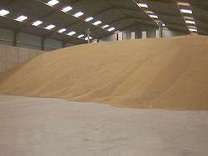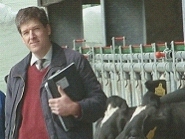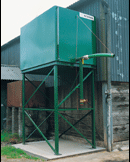Offsetting High Feed Costs on Dairy Farms
 Whilst dairy farming has come through some very difficult years, all the indicators
are that we can be optimistic about the future with worldwide demand for milk increasingly rapidly, surpluses a thing of the past and the UK market
price for milk rising.
Whilst dairy farming has come through some very difficult years, all the indicators
are that we can be optimistic about the future with worldwide demand for milk increasingly rapidly, surpluses a thing of the past and the UK market
price for milk rising.
Predictions are that feed prices will also rise further and will remain at higher levels than we have seen in recent years as a result of increased demand for bio-fuels. Despite other costs having risen, higher milk prices should bring profit opportunities for dairy farmers.
Palm oil and protected fats have risen sharply by over �100 per tonne. The temptation is to immediately drop protected fat and any other expensive feeds from the diet and manage without, or to buy something lower energy for less. It should however be noted that the price of palm fat has risen by 20% and the price of concentrates has risen by 50%. If fat was cost effective to feed last year it probably is cost effective this year.
Very often higher priced inputs offer better value for money, are more effective and add more to the bottom line. Reducing the energy content of the diet can with a fair degree of certainty be predicted to eventually reduce milk quality, milk yield, milk income and to extend the calving index. The truth is that price increases will affect all feeds across the board with the possible exception of molasses.
What is the most effective way to offset rising input prices?
It is important to concentrate on the bigger picture. Ask searching questions? Is the overall diet doing what it should? Is rumen function as efficient as it could be? Can the overall feeding system be improved to achieve a higher output? What issues affect overall herd performance? What can be done to improve feet, fertility, cell count, longevity and milk output?
Milk output is the main driver of dairy farm profitability. Focusing too heavily on reducing the cost per tonne by 1% or 2% or on taking out the odd input cost here and there, will not increase output and usually is a distraction from the real issues which actually cost farm business money in lost output. Ever heard the phrase "Too busy saving a penny to make a pound"?
Ask yourself, is your objective to increase bottom line profit by lifting output, improving feed efficiency and getting more from forage? or is it simply to reduce input costs to help with short term cash flow? If it is the latter then how much is this impacting on overall farm profitability?
Are you investing enough time into managing your forage and your diets?
 The importance of efficient rumen function in maximising feed efficiency, fertility and herd health cannot be over stressed. How well are your diets
designed? Could they be improved? Could you get more output from the same feed inputs? Do you invest enough time and effort in getting your feeding
systems and diets right?
The importance of efficient rumen function in maximising feed efficiency, fertility and herd health cannot be over stressed. How well are your diets
designed? Could they be improved? Could you get more output from the same feed inputs? Do you invest enough time and effort in getting your feeding
systems and diets right?
Nutrition isn't all about concentrates and which is the best or cheapest cake to feed. It is much more about forage, dry matter intakes, rumen efficiency and herd management.
How good is your outside nutritional advice? and does it encompass all aspects of nutrition including how the youngstock are reared, the forage varieties that you grow and how the forage is conserved to provide the best nutrition for the herd, and much more?
Molasses - The Need for Sugar
Molasses is the one exception to rising feed costs. Molasses is currently a very competitively priced source of energy with lots of other benefits. If you are not currently using molasses, look at it again.
 Feeding optimum sugar levels can, increase
the rate of digestion in the rumen and lift dry matter intake as well as improving the efficiency
of protein utilisation by up to 25% allowing savings on purchased concentrates and protein.
Feeding optimum sugar levels can, increase
the rate of digestion in the rumen and lift dry matter intake as well as improving the efficiency
of protein utilisation by up to 25% allowing savings on purchased concentrates and protein.
The benefits from feeding sugars will apply whether the sugar is in the grass or added to the total mixed ration. The important factor is that the sugar is fed in the forage or whenever the cow feeds, not at either end of the day.
Molasses also increases palatability of a TMR and reduces sorting. Feeding molasses therefore can increase forage intake, reduce the risk of acidosis and reduce reliance on both the amount of concentrate and the amount of protein purchased.
In addition with a higher proportion of rumen degradable protein utilised, blood ureas are likely to be reduced, especially the peaks after feeding, which can only be beneficial in terms of energy requirement, feet and fertility.
Summary
- Feed prices in future are likely to remain at higher levels than we have been used to in the past, but then at the same time so are milk prices
- The most effective means of offsetting rising feed prices is still to feed cows to produce high yields in order to spread overhead costs over more litres
- Dairy cow diets should be balanced to provide maximum rumen efficiency to get the most out of increasingly costly feeds
- Full advantage should be made of new techniques, technical developments and new grass, clover and maize seed varieties
- Molasses offers many advantages in getting more from the rest of the diet
- All the indicators are optimistic about the future. In addition, I cannot remember a time where there have been so many exciting new advances in forage crops, forage conservation, feeding and dairy nutrition open to dairy farmers
Higher milk prices should encourage re-investment and uptake of these new advances to allow cost savings and greater profitability for dairy farmers.
Contact Richard Webster for advice on making more of forage to control costs
